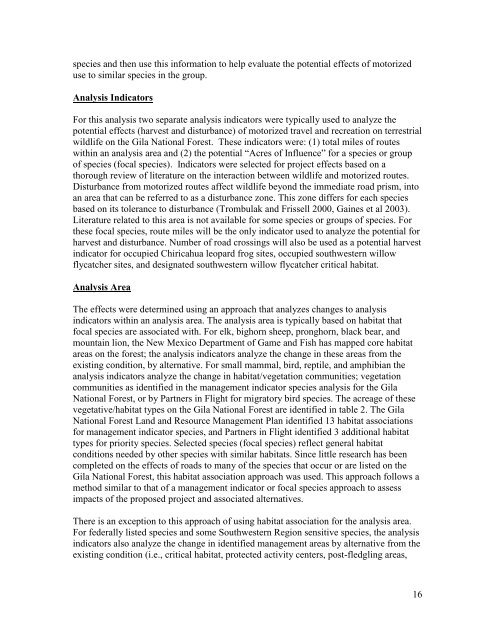Wildlife Specialist report
Wildlife Specialist report
Wildlife Specialist report
You also want an ePaper? Increase the reach of your titles
YUMPU automatically turns print PDFs into web optimized ePapers that Google loves.
species and then use this information to help evaluate the potential effects of motorized<br />
use to similar species in the group.<br />
Analysis Indicators<br />
For this analysis two separate analysis indicators were typically used to analyze the<br />
potential effects (harvest and disturbance) of motorized travel and recreation on terrestrial<br />
wildlife on the Gila National Forest. These indicators were: (1) total miles of routes<br />
within an analysis area and (2) the potential “Acres of Influence” for a species or group<br />
of species (focal species). Indicators were selected for project effects based on a<br />
thorough review of literature on the interaction between wildlife and motorized routes.<br />
Disturbance from motorized routes affect wildlife beyond the immediate road prism, into<br />
an area that can be referred to as a disturbance zone. This zone differs for each species<br />
based on its tolerance to disturbance (Trombulak and Frissell 2000, Gaines et al 2003).<br />
Literature related to this area is not available for some species or groups of species. For<br />
these focal species, route miles will be the only indicator used to analyze the potential for<br />
harvest and disturbance. Number of road crossings will also be used as a potential harvest<br />
indicator for occupied Chiricahua leopard frog sites, occupied southwestern willow<br />
flycatcher sites, and designated southwestern willow flycatcher critical habitat.<br />
Analysis Area<br />
The effects were determined using an approach that analyzes changes to analysis<br />
indicators within an analysis area. The analysis area is typically based on habitat that<br />
focal species are associated with. For elk, bighorn sheep, pronghorn, black bear, and<br />
mountain lion, the New Mexico Department of Game and Fish has mapped core habitat<br />
areas on the forest; the analysis indicators analyze the change in these areas from the<br />
existing condition, by alternative. For small mammal, bird, reptile, and amphibian the<br />
analysis indicators analyze the change in habitat/vegetation communities; vegetation<br />
communities as identified in the management indicator species analysis for the Gila<br />
National Forest, or by Partners in Flight for migratory bird species. The acreage of these<br />
vegetative/habitat types on the Gila National Forest are identified in table 2. The Gila<br />
National Forest Land and Resource Management Plan identified 13 habitat associations<br />
for management indicator species, and Partners in Flight identified 3 additional habitat<br />
types for priority species. Selected species (focal species) reflect general habitat<br />
conditions needed by other species with similar habitats. Since little research has been<br />
completed on the effects of roads to many of the species that occur or are listed on the<br />
Gila National Forest, this habitat association approach was used. This approach follows a<br />
method similar to that of a management indicator or focal species approach to assess<br />
impacts of the proposed project and associated alternatives.<br />
There is an exception to this approach of using habitat association for the analysis area.<br />
For federally listed species and some Southwestern Region sensitive species, the analysis<br />
indicators also analyze the change in identified management areas by alternative from the<br />
existing condition (i.e., critical habitat, protected activity centers, post-fledgling areas,<br />
16
















